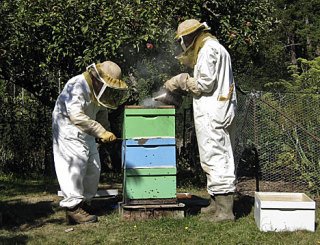Honeybees are a presence in many Lopez gardens. I’d noticed them most recently in my mid-September garden, busy on the purple blooms of anise hyssop and summer savory. Wanting to know more about bees and beekeeping, I called Kevin Murphy and Mary Hayton, whose hives I’d noticed in their garden off Farm Road.
When I arrived at Kevin and Mary’s, they were dressed in white full-body bee suits, veils and gloves. They helped me into a veil, gave me some gloves and showed me what was going on in the hives.
They were checking their hives for mites, a parasite that can kill the hive in a couple of years. They had recently treated the hives with a formic acid fumigant. “It’s one of the least toxic treatments for these varroa mites. We tried it last year at this same time of year and our bees survived the winter so we thought we’d try it again.”
They were also looking for the queen. Showing me a frame he’d just pulled out, Kevin explained, “This is a frame of brood or baby bees. Bees go through different stages: they start as an egg, became larva, then pupa — the pupas are inside the caps — then they will emerge looking like these full grown bees.”
“The bees will build a frame out evenly although you can see that it’s a little bit odd in this corner. That’s where they raise the boys, the drones. The drone’s job is to fertilize the queen, so we would rather have mostly workers — the girls — and just a few boys.”
“And this much larger cell,” he concluded, “was a queen cell where they raised the queen.”
“Oh, here she is right here, there’s the queen,” Mary interrupted, pointing to a larger bee amid the mass of workers. With this good news, we left the hives and sat down in the shade to talk more about beekeeping.
Kevin has been keeping bees for 30 years and Mary started working bees with him 18 years ago. “When we think about why we keep bees now, it’s that bees are a part of our life. It is so seasonal and every season has a new activity.”
“In the late winter when they first come out for the crocus, I think ‘Oh, hallelujah,’ we have something alive,” Mary said. “Our long cool springs are a challenge for the bees to feed and increase their population,” they added. “We lost lots of brood during the April snow storm this year,” Kevin said. “The queen had laid eggs but they couldn’t keep them warm enough. It’s affected the whole season.”
“When we get the raspberry bloom,” Mary continued, “We say, okay now the honey flow is about to start.” “Then in June the bees are just totally busy all day long. ” Kevin added: “You can tell that they have a lot of nectar.”
“Usually August is quite a frenetic time for us because we take off the supers, the top box of the hive where the bees store only honey and pollen, and try to process that honey right away. We took off our honey late this year because the blackberries were still blooming.”
“And from now on it sort of slows down. We pretty much just sit and pray for not too harsh a winter.”
We stood up and as Kevin and Mary returned to checking their hives, they said: “Another reason we keep bees is because it is fascinating. It is totally complex. Even after many years of beekeeping, we are learning more about them all the time.”



